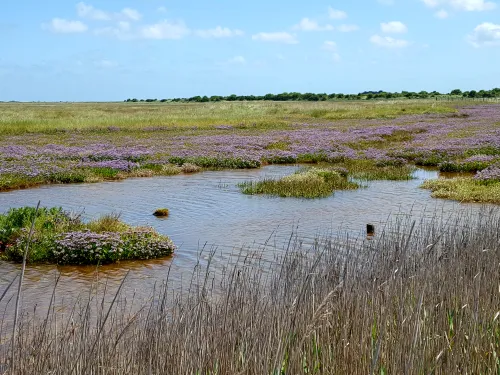
What my Kent Wildlife Trust membership means to me
Teacher, campaigner, and member Kerry Sabin-Dawson talks all about her membership journey in this blog.

Tim Horton
Canterbury was voted as one of the top 10 places to have brought about positive change, thanks to the Wilder Blean Project, a wilding initiative using wild bison as ecosystem engineers to combat the biodiversity crisis and make the landscape more resilient to climate change.
saw the release of the 2022 Bugs Matter report for Kent. Bugs Matter is a national citizen science project in partnership with Buglife asking people to count bug splatters on their vehicle windscreens as a way of monitoring insect populations. Alarmingly the survey revealed that insects had declined by 75% in Kent over the last 20 years.
all eyes were once again on West Blean and Thornden Woods as the conservation grazing animals; Exmoor ponies, longhorn cattle and Iron Age pigs were released to the woodland as part of the Wilder Blean Project. This month also saw the first Wilder Carbon projects validated by the soil association. One of the projects is a rewilding initiative at Heather Corrie Vale, an abandoned golf course in the Darenth Valley. The restoration of these projects, funded by carbon finance, will make them wildlife rich and climate resilient, and keep carbon locked up into the future.
and the Trust were busy preparing the launch of their Wilder Kent 2030 strategy, outlining three main goals which will help create a wilder, better future for people in the county.
with the Trust asking people to respect marine wildlife, in particular the seal colony at Pegwell Bay. These magnificent creatures had been subjected to ongoing disturbance from recreational water sports activities as the weather improved.
the Trust welcomed some late lambs to the flock after a surprise birth for a ewe who had lost a previous pregnancy following a dog attack. The good news was an opportunity for the charity to campaign for dog owners to behave responsibly around livestock.
when finally, after much anticipation, red-billed choughs were released over the white cliffs of Dover. This flagship species reintroduction was made possible through a partnership with Wildwood Trust and supported by Paradise Park in Cornwall.
no one could have anticipated the media frenzy that a mystery totem pole could cause in Capel-Le-Ferne. The surprise sculpture appeared overnight, placed there by an unknown person under the cover of darkness. To this day, the origin story of Perkūnas the pole remains a mystery.
proposed changes in Nutrient Neutrality laws inspired the Trust to launch its ‘Save Our Stour’ campaign, highlighting the need for better protection for our waterways. Some members of the charity also donned their best bib and tucker to celebrate the organisation being awarded the best animal and environmental charity of the year at the Kent Charity Awards. However, the real hero of the night for Kent Wildlife Trust was Bill Hickmott, who now in his 80s, was handed a certificate after being shortlisted in the volunteer of the year category for his long service to the Trust.
was upon us as was the launch of the eagerly anticipated Planet Earth III presented by none other than Sir David Attenborough himself. The award-winning nature documentary series is championed by conservationists over the globe and Kent Wildlife Trust was honoured to play a small but significant role in bringing it to our screens as Downe Bank Nature Reserve in Bromley was chosen for the series opener. As the first episode aired, viewers were treated to the sight of Sir David walking along the historically significant slopes of Downe Bank, where Charles Darwin conducted his studies.
Also launched in October in preparation for fireworks night, the Nature Nightmares campaign encouraged people visiting wildlife sites to behave responsibly and not let off fireworks near livestock. A fundraising appeal accompanying the campaign resulted in many generous donations from like-minded supporters who wanted to contribute to the clean-up operation.
proved perfect for mushroom spotting with a rare candelabra coral fungi found in West Malling. This is thought to be one of a handful of registered spots in Kent.
As people began to put up their Christmas trees and hang out their sparkling lights, Kent Wildlife Trust launched the “Rethink Sea Link” campaign, asking the National Grid to consider alternative, less environmentally impactive routes, for an electricity cable linking Kent and Suffolk. The current plans impact the internationally important site of Pegwell Bay and nature haven of Minster Marshes.
led the Trust to announce the birth of a bison calf from the Wilder Blean Project herd. This little ecosystem engineer is the first wild bison to be born and bred in the woodland.
Kent Wildlife Trust’s Charlotte Lewis reflects on 2023:
We are incredibly proud of what we have achieved in 2023, the steps taken to protect and restore wildlife, inspire and collaborate with our supporters and strengthen and grow as an organisation has surpassed what we could have expected. In short, it has been a wild ride.
Somehow we even found time to launch our very own podcast with TV presenter Rob Smith, Talk on the Wild Side, which explores all the steps being taken to create a wilder world and tackle eco-anxiety.
Looking forward to 2024, there is so much more to come and so much more to say as we head towards a general election. Now is the time to speak up for nature and change the fate of our nation. Those who are interested in supporting us on our wild journey can join as a member, volunteer, donate or simply share our messages. Together we can make a difference and create a greener, wilder Kent.

Teacher, campaigner, and member Kerry Sabin-Dawson talks all about her membership journey in this blog.

Natasha Ruskin explores something terrifying: a world without woodlands.

Ever wondered how planting trees or restoring soil can help fight climate change? Carbon sequestration is nature’s quiet housekeeping - learn more in this blog.